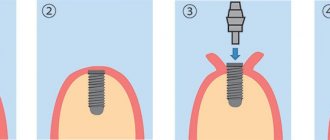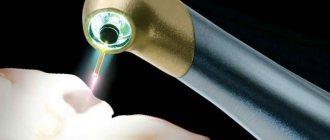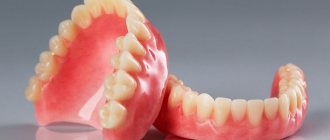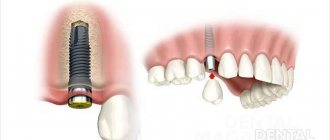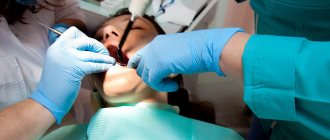- 3d dental implantation
- Basal dental implantation
- Non-surgical dental implantation
- Dental implantation
- Two-stage dental implantation
- Dental implantation
- Teeth replacement
- Implantation of 1 tooth
- Implantation into the root of the tooth
- Implantation of upper teeth
- Implantation of all teeth
- Implantation of chewing teeth
- Dental implantation all on 4
- Dental implantation all on 6
- Dental implantation under general anesthesia
- Dental implantation under sedation
- Dental implantation with immediate loading
- Dental implantation with plastic surgery
- Implantation of jaw teeth on a turnkey basis
- Implantation of molars
What does basal dental implantation mean?
This term refers to the technique of implanting special implants not just into the jawbone, as with classical implantation, but into its deep parts. The term basal in the name of the technique indicates that the implant penetrates the basal layer of the bone. The peculiarity of the technique is that it allows prosthetics to be performed in a fairly short period of time - within one week, or even less.
Patients in dental clinics should also know the alternative names for basal implantation: transgingival, single-stage, minimally invasive, single-phase or implantation with immediate loading.
The main point of the basal method of dental implantation is the very rapid restoration of chewing load - the installed dentures can be loaded within 3-5 days after completion of all procedures. As part of the technology, the dental surgeon also uses the zygomatic bone to securely fix the implants in the jaw (when replacing the upper jaw). When placing implants, the force lines of the skull are taken into account, which allows for optimal distribution of the load on the prostheses.
Basal dental implantation allows the patient to save time compared to conventional implantation. With the classical scheme of prosthetics on implants, from the moment of installation of the implant to prosthetics takes from 3 to 6 months, and with basal implantation - from 3 to 5 days. But fast does not always mean high quality, and any patient may face the problem of basal implant rejection within a couple of months.
We note the rapid growth of patient interest in basal implantation and would like to meet their expectations. But! Having carefully studied the issue of basal implantation, we came to the conclusion that the technique is too ambiguous. In addition, in most European countries, where this method is supposedly actively used, it has almost been abandoned due to the high risk of complications. This is why basal implantation is not encouraged or used at Dent Academy - we try to follow European recommendations.
Advantages of the technique
- Basal implantation can be used with virtually no restrictions; basal implants, due to their specific shape, can be inserted into areas of the bone where it is impossible to install traditional screw implants.
- The need for bone augmentation and transplantation, accompanied by serious surgical interventions, is eliminated.
- One-stage dental implantation allows you to immediately implant a basal implant after tooth extraction and immediately load the prosthesis 3-4 days after the procedure.
- The low degree of trauma and accelerated healing time contribute to the inclusion of this procedure in the category of bloodless operations. Due to their bloodlessness and low morbidity, basal implants can be implanted in patients with HIV, hepatitis, and diabetes.
Types of Basal Implants
There are two types of basal implants: disc and compression. Disc ones are not currently used, having given way to more modern compression ones.
Disc implants
During the era of basal dental implantation, disc implants, also called lateral basal implants, were developed and actively used. To install them, a rather traumatic operation was required, during which the gums were cut and the bone was sawed out. For this reason, disc basal implants were gradually replaced from clinical practice by more convenient compression ones.
Compression implants
The development of dental surgery has led to the emergence of a new generation of basal implants - compression or root-shaped. These implants are similar to conventional ones, but are larger in size, allowing them to “reach” the basal layer of bone.
Basal implants are produced in different countries and are represented on the market by a large number of manufacturers. Dental clinics usually use implants from 2-3 manufacturers - this is enough to cover the entire price range.
Dental implantation in dental clinics in Orel
- Denta+
- Sovetskaya street, house 11
- +7 (4862) 47-… show all
- Mon-Fri 9:00–20:00; Sat 9:00–14:00
4.5 ratings: 6
- Dental clinic practice dent
4.4 ratings: 5
- Clinic St.Dent
3.8 ratings: 5
- Dental office
3.8 ratings: 5
- Biostom
3.8 ratings: 5
- Dynasty
4.4 ratings: 5
- Almazdent
4.5 ratings: 4
- Dental clinic Bogdanova n n
4.8 ratings: 5
- Smile
4.0 ratings: 3
- Dentistry Center 32
4.0 ratings: 8
- Pearl
4.3 ratings: 9
- Guarantor, sir
4.0 ratings: 4
Further
Dental implants: types and prices with photos
The quality of basal implants from all well-known manufacturers is approximately comparable - it is very difficult to identify the leader among them, since it is impossible to objectively compare the number of complications, service life and the presence of defects. In addition, to a certain extent, these indicators depend on the “straightforwardness” of the doctor installing the implant. Therefore, briefly about implants from well-known manufacturers:
- Nobel Biocare (Switzerland). The implants of this company are made of titanium, which has a high degree of biocompatibility. The external coating of Nobel implants is represented by TiUnit material, which is titanium oxide enriched with phosphorus and has a high degree of crystallization. This coating provides moderate surface roughness of the implant, which increases their survival rate and reduces adaptation time. Nobel Biocare is one of the leaders in the production of implants and equipment for implantology; the company provides a lifetime guarantee on its products. The quality of the product also corresponds to the price - the cost of an implant for basal dental implantation starts from 60,000 rubles.
- Straumann Roxolid (Switzerland). This company uses a special alloy in the production of its implants, which in some respects is not inferior to titanium. Dental implants from Straumann Roxolid are thin, short implants with a special coating that facilitates installation in patients with several concomitant diseases. The price of these implants is slightly lower than the prices of flagships from Nobel - the average cost of one Straumann Roxolid implant is 50,000 rubles.
- Oneway Biomed (Switzerland). Biomed implants are recognized leaders around the world among all immediate loading implants. The Immediate Load implantation protocol developed by the company in addition to implants made the prosthetic procedure so convenient that many implantologists with conservative views began to introduce it into their practice. Biomed implants are distinguished by a super-smooth surface that prevents the absorption of microorganisms. These implants are suitable for prosthetics in the most advanced cases - in patients with severe atrophy of the jaw bone tissue and severe periodontitis. With the cost of one Biomed implant being 25-35 thousand rubles, basal dental implantation of one jaw will cost about 200,000 (all-in-6 or all-in-4 protocol).
- Noris Medical (Israel). The implants from this manufacturer are focused on zygomatic (zygomatic) implantation, so their length exceeds the length of all other implants. In more than half of cases, zygomatic implantation is associated with the need to compensate for bone tissue deficiency. In this regard, Noris Medical offers doctors complete systems that include all the necessary components. The price of basal dental implantation with upper jaw prosthetics using all-in-6 or all-in-4 protocols using implantation systems from Noris Medical can reach several hundred rubles (this is the cost of zygomatic implantation of the upper jaw).
- Ankylos (Germany). The popularity of this company's products is due to their lower price category. The design features of implants from this manufacturer reduce the likelihood of their loosening. In the manufacture of implants, the patented FIRADENT Plus technology is used, thanks to which, after installation, more active formation of bone tissue is observed in the peri-implant space.
- BioHorizons (USA). The fame of this American brand is due to some extent to the fact that the company has developed a special coating for its implants - Laser-Lok. Thanks to it, the fusion of the implant with the bone tissue is accelerated. The company also patented the TeethXpress technique, which is a modification of All-on-6 and is intended for complete jaw replacement. This technique has only one drawback - for high-quality prosthetics it requires absolute parallelism between the implants, which cannot always be ensured in case of severe atrophy of bone tissue.
- Osstem Implant (South Korea). The South Korean company is one of the top 5 manufacturers of dental implants and implantation systems, accounting for 80% of the South Korean market. The company's products are quite affordable - the cost of one implant is 20,000 rubles. Since 2006, Osstem has been producing implants at its plant in the USA and selling them under the HIOSSEN brand.
Causes of jaw bone deficiency
The effectiveness of a labor-intensive procedure aimed at maximizing the improvement of the jaw depends on the volume of bone tissue, which tends to deteriorate during a person’s life for the following reasons:
- inflammatory processes in a decaying tooth;
- injuries of the maxillofacial apparatus;
- destruction of bone tissue due to surgical removal of a tooth, that is, most dentists perform this operation with the capture of the alveolar process or part of it;
- resorption of bone tissue due to sharply reduced pressure on it due to the absence of a tooth;
- congenital deficiency, which is manifested by malocclusion, speech defects, as well as aesthetic nuances.
Bone deficiency can be noted both in height and in width of the anatomical part bearing the dentition. Almost all types of reduced volume of the bones of the lower or upper jaw can be restored using modern methods. Of course, there are some disadvantages of bone grafting , but, in this case, the end justifies the means.
Pros and cons of basal implantation
Dental prosthetics based on the basal implantation technique is a very controversial technique, which has more significant disadvantages than advantages. It is most often offered in cases of complete edentia, when absolutely all teeth are missing on one jaw. Basal dental implantation is used in cases of severe atrophy of bone tissue without prior augmentation.
Basal implants are installed faster than usual, and the patient receives the desired effect in the form of restored dental integrity in the shortest possible time. However, this is accompanied by a fairly high risk of implant failure in the early stages.
Dentures on basal implants, however, as well as on conventional ones, do not require special care - it is enough to brush your teeth as usual or use an irrigator. When using all-in-4 and all-in-6 dentures, a small gap is usually left between the denture and the gum to facilitate oral care, which can be easily cleaned with a simple rinse.
Basal implantation is impossible without the use of computer technology - before the procedure, the implantologist must create a 3D model based on a CT scan of the jaw, which will help calculate the installation of implants. Unfortunately, many doctors neglect this need, saving on software, which leads to very sad results.
So, let’s briefly note the advantages of basal dental implantation:
- quick installation;
- the patient gets the opportunity to return to a normal lifestyle - chewing function is quickly restored, the cosmetic defect (lack of teeth) and the resulting psychological discomfort disappear;
- there is no need to build up bone tissue in case of severe atrophy;
- bone tissue regenerates faster due to immediate load on it;
- lower cost compared to alternative prosthetic methods.
Disadvantages of basal implantation
Doctors at Dent Academy are proficient in all methods of prosthetics, and we do not need to praise one method at the expense of another. Therefore, we will also talk about the disadvantages of basal prosthetics. And you will understand why this technique is not used in our clinic.
One of the serious disadvantages that should be immediately noted is the rather high complexity of the procedure itself - not every doctor is able to perform basal implantation. Specialists proficient in this technique must first undergo training at the International Implant foundation, ultimately receiving a certificate. A doctor who knows this technique is both an orthopedist and a maxillofacial surgeon rolled into one. Our clinic has specialists who have completed all the necessary training, but this does not allow them to abuse the trust of patients and offer them a rather dangerous technique.
Important! In case of rejection of the basal implant, the patient will still have to resort to classical implantation with sinus lift. And this happens quite often, which is why we do not use this method of prosthetics.
New or old technology?
The development of implantation since the 60s of the 20th century has been based on two different technologies. The founder of modern dental implantology, Swedish doctor Per-Ingvar Brånemark, came up with root-shaped implants that were implanted in two stages. The phenomenon of osseointegration, discovered by scientists from Sweden, proved that a titanium rod implanted into bone tissue was able to completely fuse with the bone, becoming motionless, strong, and stable.
American professor Leonard Linkov invented implantation systems similar to blades or thin plates (blades). To implant them, it was necessary to cut out a bed in the basal tissue of the bone, where a plate with a pin was placed. A crown was then placed on it, and the implant itself was integrated into the bones, overgrown with connective tissue.
At that time, basal dental implantation became an ideal option for those patients for whom root-shaped implants were contraindicated due to insufficient bone tissue for their implantation.
Later, basal technology was improved in 1982 by the French scientist Jean-Marc Julier. The scientist proposed an implant in the form of an inverted letter T with a longer root part than that of classical products. It was not installed in the spongy porous tissue of the jaw bone, where the roots of the teeth are located, as with traditional implantation, but in deeper layers - the basal ones.
At his instigation, the method of implanting implantation systems for bone tissue atrophy, if the patient has insufficient volume, began to be actively introduced in dental clinics in Europe. The basal bone is not subject to atrophy and has fewer capillaries. Such characteristics made it possible to carry out dental implantation even with a significant lack of the upper layer of the jaw bone.
However, by the beginning of the 90s, European dental associations agreed that the effectiveness of basal implantation was low. In practice, it turned out that implants implanted in this way served much less than root-shaped ones and could not withstand the chewing load.
However, the collapse of the Iron Curtain between Russia and Europe in the 90s opened the way for ineffective basal implantation in dental clinics in Russia and the CIS countries.
Indications and contraindications for basal prosthetics
Supporters of basal implantation are trying to present this technique as almost a panacea and the list of indications for it is very large. We are not supporters of this method, so we cannot recommend it in any situation.
“The practice of using basal implantation in European countries has shown that it can cause too much damage to the patient’s health. Therefore, in some countries this method was banned at the state level.”
Chief physician of the Academy of Dent Sadov Igor Yuryevich, a specialist with more than 20 years of experience, member of the European Association of Implantologists, member of the International Congress of Dental Implantologists.
The list of contraindications to this method is quite extensive:
- oncopathology;
- decompensated diabetes mellitus;
- tuberculosis;
- untreated arterial hypertension;
- severe disorders of the coagulation system (hypocoagulation);
- pronounced hypertonicity of the masticatory muscles.
Ages under 22 years are a contraindication for this implantation method, since until this age the growth and formation of bones, including jaws, continues
This is interesting! Smoking is a relative contraindication to any type of implantation, due to the fact that smokers have almost 5 times lower chances of successful implantation. This is due to the fact that long-term smoking leads to a decrease in bone density, deterioration of microcirculation in tissues, and slower regeneration. Unscrupulous marketers claim that basal implantation is more effective in smokers, but there is no confirmation of this fact - the percentage of rejection of basal implants in this category of patients is no higher than the percentage of rejection of conventional ones.
What dentists say
The opinions of dentists regarding basal implantation are ambiguous. Some are categorically against this technique, others accuse opponents of basal implantation of conservatism and even a lack of professionalism.
The chief physician of the Center for Reconstructive Surgery and Implantation believes that basal implantation is nothing more than an attempt to deceive the biomechanics of chewing. Non-root-shaped basal implants with the thickness of a matchstick do not withstand chewing overload. This leads to resorption of the last boundaries of the bone and rejection of the implants. Naturally, the results of basal implants with immediate loading are in many ways inferior to classical technology.
Other implantologists (including doctors of medical sciences, professors, academic members of the Russian Academy of Sciences), based on their many years of experience in implantology, are categorical in their statements, openly saying that basal implantation is “pure deception.” They insist that this is not an innovative, but rather a medieval method, and in no case should it be a full replacement for classical implantation.
Dentists with foreign experience criticize basal jaw implantation even more: they harshly condemn the method of filing non-removable abutments. According to the chief physician of one of the specialized private clinics, they stick out like anti-tank hedgehogs right in the client’s oral cavity. The doctor is surprised: “What does it mean to saw high-strength titanium in the mouth? Try sawing off a piece of metal reinforcement using your head as a support. And you will feel the fullness of the upcoming sensations. In a word, the most perfect collective farm and primitivism compared to modern Brånemark systems, where the implant and the superstructure (abutment) are not one whole.”
However, dentists do not categorically deny basal implantation, giving it a place in critically extreme cases when it is impossible to carry out the classical protocol:
- for serious injuries and injuries to the jaw bones;
- in most cancers associated with the loss of a large mass of tissue;
- with severe inflammation, acute bone resorption, large loss of tissue of the jaw bones and the impossibility of their growth.
Although, as practice shows, with the development of modern technologies for bone tissue restoration, the need for basal implantation is finally becoming a thing of the past.
Doctors recommend low-traumatic methods as an alternative to basal implantation
Basal prosthetics for complete absence of teeth - price
Many clinics promote basal implantation as a cheaper method of dental prosthetics for completely edentulous patients. Indeed, even a superficial analysis of the prices for these two methods shows: the average price of one tooth restored using classical implantation in Moscow is about 40-45 thousand rubles, and when restoring the entire jaw using basal implantation, the price of one tooth is about 20 thousand.
The cost of prosthetics for the entire jaw will largely be determined by the implants chosen by the patient: if you choose budget models, it will be possible to keep within 200,000, and if you choose premium implants, the price for basal implantation in Moscow can be 500,000 rubles.
We urge our patients not to chase cheapness and approach the choice of prosthetics method with all seriousness. Despite the fact that we do not use basal implantation, we will select a method of prosthetics for any patient, taking into account his financial capabilities. In this case, the main selection criterion will be health safety!



